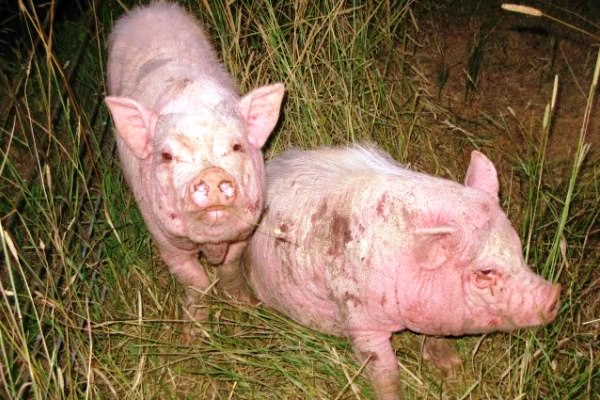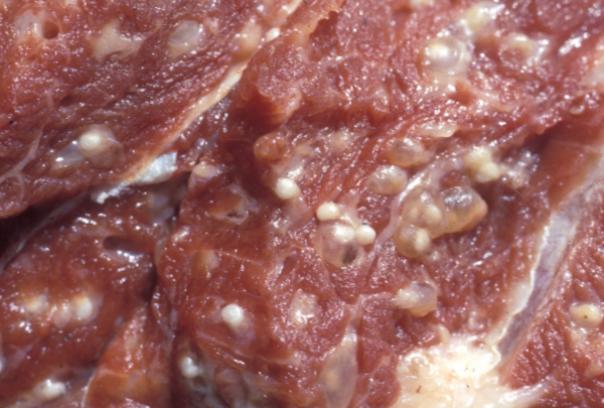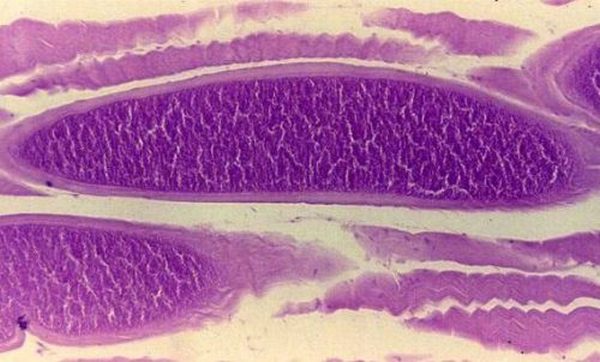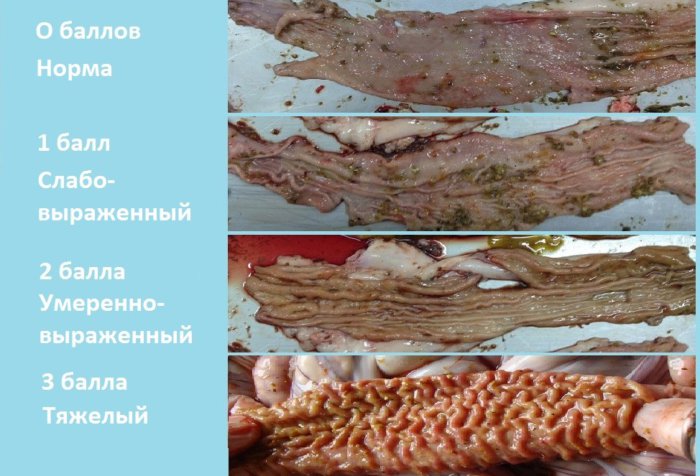Content:
- Scabies
- Trichinosis
- Pasteurellosis
- Cysticercosis
- Reproductive and respiratory syndrome
- Circovirus damage
- Aujeszky's disease
- Pork balantidiosis
- Metastrongylosis
- Actinobacillus pleuropneumonia
- Dysentery
- Echinococcosis
- Esophagostomosis
- Trichocephalosis
- Sarcocystosis
- Salmonellosis
- Polyserosite
- Paratyphoid
- Colibacillosis
- Clostridiosis
- Vesicular disease
- Ileitis
- Treatment and prevention methods
This article will tell you about pig diseases, symptoms and treatment. When a pig can be observed lying down and not eating, the reason is often related to the fact that it is sick. This is hardly a non-communicable disease. Let's consider the most dangerous diseases.
Scabies
This disease is often referred to as itchy scabies. Its more accurate name is pig sarcoptic mange. This disease is invasive in nature. This term refers to diseases that animals get sick if insects take the main part in their spread. In this case, this role is played by an itchy mite. Its exact name is Sarcoptes suis.
This mite is an intradermal parasite. At a suitable temperature and humidity, insects remain viable for 11 days.
Usually already sick animals are the source of infection. Tick transmission occurs by direct contact. It can also happen through objects when caring for animals. Due to poor hygiene, you may have to cry when looking at dying animals.
The question of the possibility of acquiring immunity by a pig has not yet received a final decision. However, it is known that in some cases a disease from an acute one can turn into a chronic form, remaining in the body in the future in a weakened version.
The strongest susceptibility to infection is in pigs less than six months old. Symptoms first appear after 14 days.
With a disease, the animal not only feels severe itching at the site of infection, but also an increase in body temperature. The whole body is gradually affected, here is a description of the course of the disease:
- At first, inflammation begins on the skin around the eyes, on the cheeks and inside the ears, red spots are formed.
- Further, the infection spreads to the back, as well as other parts of the animal's body.
- Gradually, nodules form on the skin, and scales appear at the site of combs.
- On the lower abdomen and inside the auricles, multiple eruptions are formed that have a red color.
External signs of the disease will also be aggravated. At the same time, the skin will become thicker and lose elasticity.
At the age of six months, the disease often becomes chronic. The inflammation remains in several places and the symptoms are relieved.
When diagnosing, a skin scraping is usually used, which is taken along with the ichor from the inflamed areas.
Trichinosis
Infection occurs as follows. Females live in the body for no more than 8 weeks, during which time they give birth to about 2000 larvae. They gradually spread throughout the body. However, their viability is ensured only when they inhabit the transverse muscles. They grow actively and after about 30 days create a cocoon around themselves. In this state, they can be in the body for up to 27 years, without provoking repeated outbreaks of the disease.
Gradually, the capsules are impregnated with various substances. In some cases, this can lead to the death of the larvae.
Females injure the intestinal mucosa and can damage blood vessels. They can cause thrombosis or hemorrhage.
Usually in pigs, symptoms begin to appear 3-4 days after infection. Animals become lethargic and lose their appetite, at this time they almost always lie down. The feces become thin and offensive, and diarrhea occurs. There are convulsions, vomiting, which are accompanied by severe itching. The disease lasts up to 1-1.5 months. At this time, the formation of capsules in the larvae occurs. After that, the symptoms gradually go away.
Pasteurellosis
Here we are talking about one of the most dangerous diseases that pigs can get sick with. On occasion, they are capable of infecting a person.
If untreated, pig pasteurellosis is fatal in 70% of the animals.
In this disease, blood poisoning occurs, as a result of which hemorrhagic changes occur in the upper part of the lungs and in the intestines.
The causative agent is the bacillus Pasteurella multicida. It can survive in a humid environment for three weeks, and in meat that has been frozen for up to one year.
One of the main causes of infection is non-compliance with hygiene standards in the pigsty. Additional factors that exacerbate this danger are:
- severe hypothermia;
- excessive number of pigs in the pigsty;
- weakening of the animal's immunity.
The causative agent has the shape of an oval capsule. The immediate cause of infection can be touching a sick animal or eating food and water that are already infected with the bacillus.
Birds or rodents are also capable of carrying the disease. There are several ways in which an infection can enter an animal:
- Skin cuts.
- Together with food or water.
- Airborne contamination is possible.
The incubation period is different. It can last from three hours to three days. The disease can occur in several ways:
- acute form;
- hyperacute;
- chronic.
In the first case, the temperature rises sharply, reaching 41 degrees (the usual temperature in pigs is 38-39 degrees). At the same time, shortness of breath and depression appear. Often there is a cough, which is accompanied by blood discharge. Cyanosis of the mucous membranes and ears appears. Death occurs on days 3-8.
In the chronic form, the pig loses weight, the skin can become covered with eczema, the joints swell. In this case, death occurs after one or two months.
Cysticercosis
The causative agent of the disease is the Finn Cysticercus cellulosae, it is the larval stage of one of the tapeworms. He lives by parasitizing in the small intestine.
Reproductive and respiratory syndrome
Porcine PRRS is an infectious disease. Causes pneumonia and meningitis.
Circovirus damage
Swine circovirus infection is one of the most common diseases in pigs worldwide. Young piglets are affected. They experience growth retardation, anemia. This disease affects most of the organs of the pig. Circovirus is one of the most dangerous swine diseases.
Aujeszky's disease
It is characterized by the presence of an infectious process. If Aujeszky's disease in pigs affects young animals, the central nervous system of the animals becomes the target.
Pork balantidiosis
The etiology of the disease suggests that this disease is caused by bacteria from the Balantidiidae family. With balantidiosis of pigs, the large intestine is affected.
Metastrongylosis
It is caused by several species of nematodes that inhabit the pig's trachea and bronchi. With metastrongylosis of pigs, nematodes and their waste products circulate through the blood vessels, causing allergies.
Actinobacillus pleuropneumonia
In this disease, the lungs are affected. Actinobacillus pleuropneumonia of pigs leads to the development of pneumonia and pleurisy.
Dysentery
It is an acute infectious disease. In pig dysentery, blood and mucus are observed in the feces. In this case, necrosis can occur in the gastrointestinal tract.
Echinococcosis
This is a disease that is caused by helminths. Echinococcosis is provoked by tapeworms, which are parasites of dogs. Infection occurs when eating contaminated food.
Esophagostomosis
In this disease, the source of infection is helminths, which parasitize in the large intestine.
Trichocephalosis
One of the important features of this disease is that in some cases a complete cure is possible. Trichocephalosis is caused by a type of nematode called tricephalus. Reproducing in the body, they practically suck the life energy out of the animal.
Sarcocystosis
This disease, with initial infection, can occur in the absence of symptoms. Sarcocystosis is accompanied by high fever, a sharp decrease in appetite and depression. Death is unlikely. Veterinary medicine provides for the possibility of treating this disease.
Salmonellosis
The causative agent is bacteria belonging to the Salmonella group. There are three forms of the disease: acute, subacute, and chronic.
With the development of salmonellosis, the temperature rises to 42 degrees. Pneumonia, weakness, and bloody diarrhea and vomiting may develop. Since the disease is contagious, it can be treated with antibiotics.
Polyserosite
This disease is typical for postweaning piglets.
Paratyphoid
The history of this disease begins in the 19th century. With paratyphoid fever, the main blow is inflicted on the gastrointestinal system.
Colibacillosis
In most cases, colibacillosis affects young pigs during a period when the immune system has not yet been formed.
Clostridiosis
This is a disease, the nature of which is both bacterial and fungal in nature. Clostridiosis occurs in the form of diarrhea and diseases of the gastrointestinal tract.
Vesicular disease
This is an acute infectious disease.
Ileitis
In this case, changes occur in the mucous membrane of the stomach and intestines.Ileitis causes poor feed absorption and reduces weight gain in pigs.
Treatment and prevention methods
Correct and reliable diagnosis is important for treatment. In most cases, pathological analysis is performed to determine the type of disease. Achievements of parasitology make it possible to diagnose the cause of the disease with high accuracy in many cases.
Levamisole 75 is a powerful means of destroying helminths, the instructions for use for pigs indicate that it inhibits both larvae and adult worms. The maximum dose for treatment should not exceed 20 ml.
The instruction for the swine erysipelas serum says that it is suitable for use for two years. The inoculated immunity lasts for 14 days. The dosage in which it is recommended to use depends on the characteristics of the particular application.
Ruvak is administered intramuscularly to pigs. Designed for immunization of pigs of various ages. Overdose can lead to health problems.
The most important preventive measure is the observance of hygienic rules for keeping pigs. It should be borne in mind that with food they should receive calcium, other minerals and vitamins. Such nutrition will maintain strength and reduce the likelihood of illness.
When vaccinating against the most dangerous diseases in the area, the possibility of infection can be significantly reduced. In this case, you need to choose the best quality vaccine. The Armavir biofactory produces a quality remedy against erysipelas.
Vaccination will increase resistance to specific types of disease. However, medicines should be used in parallel with the use of preventive methods.
Pigs are highly susceptible to various dangerous diseases. To combat them, it is necessary not only to comply with the necessary requirements for care and maintenance, but also to help spread information about the correct methods for diagnosing and treating diseases.



















